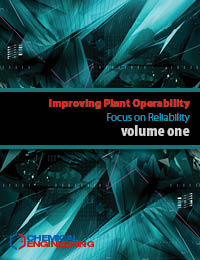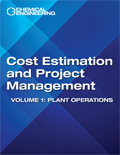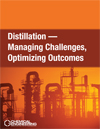Description
Volume one of this two-part guidebook contains practical, how-to engineering articles, and useful engineering “Facts at Your Fingertips” tip sheets. All were originally published in Chemical Engineering.
The collection of articles in this volume focuses on a range of reliability issues affecting a large array of equipment types and unit operations. Several articles discuss improving the reliability of pumps, valves and heat-transfer systems. Others focus on making the most of instrumentation systems that can help to improve plant reliability, while providing guidance on proper equipment selection and monitoring techniques to reduce corrosion risk.
Several articles cover optimizing overall process operations through improvement engineering and proper management of turndown and rangeability, and on improving maintenance techniques to reduce unplanned downtime.
These articles were originally published between 2008 through 2015. This guidebook is available in PDF format only. The other volume of this two-part set, entitled, “Improving Plant Operability — Volume Two: Focus on Safety,” is sold separately.
Delivered in a PDF, 233 pages.
Table of Contents
Facts at Your Fingertips: Maximizing Fan Efficiency
Facts at Your Fingertips: Pressure Measurement Considerations
Project Optimization Through Engineering
Follow these practical recommendations to reduce capital outlay and operating costs, deliver shorter schedules and improve design quality
Advances in Process Temperature Measurement: Trends and Technologies
Process temperature measurement is a constantly evolving field, and new technologies have allowed for more reliable measurements to be realized in many applications
Facts at Your Fingertips: Hot-Oil Heat-Tracing Systems
Extremely Low-Temperature Systems
Understanding the nuances of low-temperature engineering is key to safe and efficient operations
New Measurement Practices for Cold Climates
Selecting the right pressure, temperature, flow and level meters and connection systems can help to eliminate the need for heated enclosures and sensing lines
CPI Machinery: Commissioning, Startup and Piping
Practical notes on installation, piping, support, layout, nozzle-loads, stress analysis, pre-commissioning, commissioning, startup and operation of rotating machinery
Optimization of a Steam Network
Proper configuration of steam-turbine drivers affects power generation in petroleum refineries
Design Underground Piping for Safety
Buried systems bear a number of unique risks and require special considerations, including those related to soil characteristics and seismic loads
Evaluate Heat-Exchanger Tube-Rupture Scenarios Using Dynamic Simulation
Applying dynamic simulation models to tube-rupture scenarios can help ensure more accurate sizing and hazard assessments
Bulk Solids: Optimizing Screw Conveyors
Despite their apparent simplicity, the complexity of these conveying systems demands proper design and an understanding of the underlying principles
Computerized Maintenance Management Systems For Effective Plant Performance
Corralling gigabytes of predictive maintenance data isn’t easy, but it’s essential for streamlining your process
Get the Most out of Vibration Analysis
By listening to the messages your components are sending, you will be better able to assess the status of your machinery and take action to address problems
Facts at Your Fingertips: The Impact of Off-BEP Pump Operation
Gas Turbines: Design and Operating Considerations
Follow these engineering recommendations to improve gas turbine operation and performance while reducing operating costs
Valve-Selection Best Practices
Precise combinations of valves and other equipment lead to process success. A biopolymer fermentation process provides an example of proper valve selection
Maximizing Performance In Size Reduction
Expect more in selection and scaleup, prediction of energy consumption and reliability
Dynamic Modeling for Steam System Control
Dynamic modeling fills in the gaps of steady-state modeling and provides a more complete, reliable and efficient analysis
Industrial Control Systems Security: The Owner-Operator’s Challenge
Addressing the cybersecurity of industrial control systems requires a collaborative response, beginning with a realistic assessment
Combining the use of Rupture Discs with Relief Valves
Using the two devices together offers significant benefits in chemical processes. Here is how to take advantage of them
Filtration and Separation During Chemical Process Operations: Avoid Common Errors
The seven commonly made mistakes discussed here often lead to poor filtration and separation performance and many associated problems
Measuring Exposures to Aerosols and Dust
Accurate measurements of exposures to aerosols and dusts by plant personnel can be tricky. Here is some help for determining exposures and addressing uncertainties
Mitigate Corrosion in Condensate-Return Systems
Understanding the chemistry behind corrosion in condensate-return systems can aid in selecting and properly employing the best mitigation technique
Facts at Your Fingertips: Steel Corrosion
Determining Friction Factors in Turbulent Pipe Flow
Several approaches are reviewed for calculating fluid-flow friction factors in fluid mechanics problems using the Colebrook equation
Five Steps to Replacing Aged Heat-Transfer Fluid
Follow these guidelines to help ensure efficient operation of heat transfer systems, and proper exchange and disposal of aged fluids
Optimal Cooling Systems for Coastal Plants
When all economic and environmental factors are considered, a cooling tower may be the best option
Piping-System Leak Detection and Monitoring for the CPI
Eliminating the potential for leaks is an integral part of the design process that takes place at the very onset of facility design
Best Practices for the Control of Fuel Gas
Adopt these practices to ensure new project success, and to achieve safe control and reliable, efficient operation going forward
Managing Large Chemical Plant Startups
Prudent planning and scheduling during a project’s front end can lead to more expedient commissioning and startup activities
Critical Connections Demand Certainty
Understanding bolts’ behavior during routine tightening procedures helps to ensure leak-free, reliable operations
Industrial Insulation Systems: Material Selection Factors
To provide the desired functions while being exposed to harsh environments, insulation material should be carefully selected and specified to meet the design goals
Pressure Transmitter Basics: Selection Guidelines
Climbing the decision tree to pick the right pressure sensor
Pneumatic Conveying: Optimal System Design, Operation and Control
Numerous strategies and options for both dilute- and dense-phase conveying systems are presented here
Pipe Insulation: Finding the Optimal Thickness
Avoid tedious numerical calculation by using this quick, shortcut method
Optimizing Flare Operation Through Proper Design
Flare problems are often caused by the seal systems that are designed to control air ingress. Follow these troubleshooting guidelines to improve design and ensure safe, reliable flare operation
Facts at Your Fingertips: Industrial Adsorbents
Improving the Operability of Process Plants
Turndown and rangeability have a big impact on the flexibility and efficiency of chemical process operations
Calculate NPSH with Confidence
Determining net positive suction head (NPSH) can be confusing, but with these guidelines, engineers can avoid the pitfalls of incorrect calculations
Applying CPI Temperature Sensors
Don’t fall back on outdated rules of thumb that may no longer be valid, or ‘plug and play’ solutions that may not be applicable
Specifying Elastomer Seals for Plastic Piping
Careful attention to elastomer properties and variation by manufacturer can help optimize specification
Mechanical Seals Update: Pharmaceutical and Food Applications
For applications that require cleanliness, be sure your centrifugal pumps have the proper seals
Troubleshooting Tube-Deterioration Mechanisms in Direct-Fired Heaters




